My mate marmite
 Our experiences crossing from Mauritania to Senegal had left us slightly wary of border officials, but that definitely changed when we crossed into Mali. On the Senegalese side, the police and customs were cheery, chatty and helpful (if quite hard to actually find). On the Malian side, they just invited us in for lunch.
Our experiences crossing from Mauritania to Senegal had left us slightly wary of border officials, but that definitely changed when we crossed into Mali. On the Senegalese side, the police and customs were cheery, chatty and helpful (if quite hard to actually find). On the Malian side, they just invited us in for lunch.
A few kilometres of dusty plains covered with enormous baobab trees, and we found ourselves sitting outside a customs hut with three friendly douaniers, sharing their thiou and their thiep – a delicious meaty stew, and a tasty rice dish studded with vegetables, garlicky chilli paste and savoury hibiscus-leaf sauce. If all of Mali was like this, we thought, we’d probably get on OK.
 And as it turned out, a great deal of it was. We spent a lot of time in Mali sharing food with people: cooking it with them in big bubbling marmites on charcoal fires; and then eating together, with everyone gathered round one big pot using their fingers. This is partly because we’re greedy, of course; but also because people here are so sociable. And because Tabaski was coming, and the rams were getting fat …
And as it turned out, a great deal of it was. We spent a lot of time in Mali sharing food with people: cooking it with them in big bubbling marmites on charcoal fires; and then eating together, with everyone gathered round one big pot using their fingers. This is partly because we’re greedy, of course; but also because people here are so sociable. And because Tabaski was coming, and the rams were getting fat …
 We finally left the douaniers (they wouldn’t let us leave without having some watermelon, though) and made our way to Kayes, Mali’s second city.
We finally left the douaniers (they wouldn’t let us leave without having some watermelon, though) and made our way to Kayes, Mali’s second city.  Second in terms of population, that is; it’s apparently first in terms of temperature – and indeed the thermometer in our car was showing 50°C (that’s 122°F for those of you who think that way). Mind you, that thermometer only goes up to 50.
Second in terms of population, that is; it’s apparently first in terms of temperature – and indeed the thermometer in our car was showing 50°C (that’s 122°F for those of you who think that way). Mind you, that thermometer only goes up to 50.
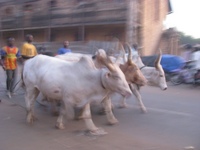 So it’s hot and dusty, but full of life and interest. We found the calabash-carving workshops, found our first proper street food (rice galettes, hot crispy slightly sweet fried balls), and drank Castel beer while watching Chelsea play Bordeaux on TV with everyone else. And most of all, we found cows: every evening, large groups of enormous humped cattle are run along the road to the slaughterhouse, to provide the next day’s brochettes. It’s quite a scene, and such a contrast to the European tendency to keep the whole animal/meat connection out of sight.
So it’s hot and dusty, but full of life and interest. We found the calabash-carving workshops, found our first proper street food (rice galettes, hot crispy slightly sweet fried balls), and drank Castel beer while watching Chelsea play Bordeaux on TV with everyone else. And most of all, we found cows: every evening, large groups of enormous humped cattle are run along the road to the slaughterhouse, to provide the next day’s brochettes. It’s quite a scene, and such a contrast to the European tendency to keep the whole animal/meat connection out of sight.
 Next stop was Diéma – not a tourist hotspot, but there’s a hotel, and the manager’s wife knows how to make millet couscous. So we had our first proper marmite session with her and her daughters, stirring the big round pot over the fire as the sun went down – then the male equivalent: beers with her husband down at the cabaret, as they call the less official bars round here.
Next stop was Diéma – not a tourist hotspot, but there’s a hotel, and the manager’s wife knows how to make millet couscous. So we had our first proper marmite session with her and her daughters, stirring the big round pot over the fire as the sun went down – then the male equivalent: beers with her husband down at the cabaret, as they call the less official bars round here.
 When we went to bed we were the only guests in the hotel, but in the morning (over hot fried beignets for breakfast) we could see that someone else had arrived in the night – and left their new ram tied up outside. Only a few days left until Tabaski (or Eid el-Kebir as they’d called it back in Morocco), the feast when all good Muslims sacrifice a ram with their family, cooking and sharing out various tasy ram-based dishes. We had to find ourselves a family …
When we went to bed we were the only guests in the hotel, but in the morning (over hot fried beignets for breakfast) we could see that someone else had arrived in the night – and left their new ram tied up outside. Only a few days left until Tabaski (or Eid el-Kebir as they’d called it back in Morocco), the feast when all good Muslims sacrifice a ram with their family, cooking and sharing out various tasy ram-based dishes. We had to find ourselves a family …
 First we headed to Bamako, following Al’s excellent recommendation by staying in the beautiful Le Djenné, the stylish and decidedly African hotel owned by former Minister of Culture Aminata Traoré. She also had the sense to open a very good restaurant serving traditional Malian food – San Toro – so we spent a fair amount of time there checking out Malian versions of by-now familiar tastes like bissap and bouye juice (just as good as they were in Senegal), and new ones like the polenta-like millet tô.
First we headed to Bamako, following Al’s excellent recommendation by staying in the beautiful Le Djenné, the stylish and decidedly African hotel owned by former Minister of Culture Aminata Traoré. She also had the sense to open a very good restaurant serving traditional Malian food – San Toro – so we spent a fair amount of time there checking out Malian versions of by-now familiar tastes like bissap and bouye juice (just as good as they were in Senegal), and new ones like the polenta-like millet tô.
 The markets had similarities and differences, too: there was no yeet any more, but lots of other preserved and feremented fish along the same lines; and people may have looked blank when we asked for nététou, but that’s just because they called it soumbala here. Same with the street food: the old pan-West-African favourite brochettes looked pretty similar, but we hadn’t come across the palm-shoot sébénougou before.
The markets had similarities and differences, too: there was no yeet any more, but lots of other preserved and feremented fish along the same lines; and people may have looked blank when we asked for nététou, but that’s just because they called it soumbala here. Same with the street food: the old pan-West-African favourite brochettes looked pretty similar, but we hadn’t come across the palm-shoot sébénougou before.
 Bamako’s certainly very different to Dakar – it’s much more spread out and doesn’t have the small-town feel or the seaside setting – but it’s incredibly lively and a fun place to hop around in taxis looking for museums, bars and music. And it also turned out to be a good place to meet people: people like Koumba, who we’d picked up hitchhiking on the road from Diéma, invite you round to meet their family and have lunch.
Bamako’s certainly very different to Dakar – it’s much more spread out and doesn’t have the small-town feel or the seaside setting – but it’s incredibly lively and a fun place to hop around in taxis looking for museums, bars and music. And it also turned out to be a good place to meet people: people like Koumba, who we’d picked up hitchhiking on the road from Diéma, invite you round to meet their family and have lunch.
 And Anna met Ibrim, owner of the Bistro Le Bafing, who very kindly invited her into the kitchen to spend some time learning some Malian dishes from Oumou and the girls. We ended up spending several days there – Anna learning all about poulet yassa, sauce arachide and more, and me mostly eating the delicious fish brochettes (you can’t beat the king of Malian fish, the Niger capitaine).
And Anna met Ibrim, owner of the Bistro Le Bafing, who very kindly invited her into the kitchen to spend some time learning some Malian dishes from Oumou and the girls. We ended up spending several days there – Anna learning all about poulet yassa, sauce arachide and more, and me mostly eating the delicious fish brochettes (you can’t beat the king of Malian fish, the Niger capitaine).
It was a lovely place to hang out and meet people, and and even better place to get to grips with the Malian kitchen – at Le Bafing they cook in the traditional way, complete with open fires, marmites all around, and traditional ingredients like the rice-like grain fonio. We definitely recommend it. We even had a chance to discuss regional specialities with Mariam Diallo, author of Slow Food’s book of Malian recipes and presenter of everyone’s favourite Malian TV cooking programme, Bien Manger. (Had our timing been better, you might have seen Anna demonstrating an En
glish recipe on the programme – we hope we’ll get another chance in future!) Very many thanks to Ibrim, Moussa, Oumou and Mariam – we’re sure we’ll be meeting again.
 We headed further inland, towards Ségou and the flat plain where the Niger widens and forms a huge delta – this is where (in the wet season) so much of the vital rice and fish comes from. The town itself is pleasant enough, but it’s the river that’s the real highlight: from sunset strolls along the bank, playing with random children and admiring people’s vegetable gardens; to boat trips up to villages of Bambara potters or Bozo fishermen.
We headed further inland, towards Ségou and the flat plain where the Niger widens and forms a huge delta – this is where (in the wet season) so much of the vital rice and fish comes from. The town itself is pleasant enough, but it’s the river that’s the real highlight: from sunset strolls along the bank, playing with random children and admiring people’s vegetable gardens; to boat trips up to villages of Bambara potters or Bozo fishermen.  (For the first time we got a sense of how rigidly defined people’s roles are in traditional society: if you’re Bozo, you fish, and move house up and down the river with the seasons and the fish; if you’re Bambara, you farm. Unless you’re born into the forgeron caste, in which case you make tools if you’re male, or pots if you’re not. All very complicated, but everything fits together.) And again, we found ourselves being invited straight over to eat with the family.
(For the first time we got a sense of how rigidly defined people’s roles are in traditional society: if you’re Bozo, you fish, and move house up and down the river with the seasons and the fish; if you’re Bambara, you farm. Unless you’re born into the forgeron caste, in which case you make tools if you’re male, or pots if you’re not. All very complicated, but everything fits together.) And again, we found ourselves being invited straight over to eat with the family.
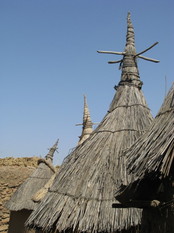 From here we went further east to the Dogon country – Mali’s biggest tourist draw. We’d been in two minds as to whether to go or not: would we have time to do it justice? Would it be too touristy? We weren’t sure, but so many people had told us we’d be mad not to go. And we’d heard they made special dried onion balls …
From here we went further east to the Dogon country – Mali’s biggest tourist draw. We’d been in two minds as to whether to go or not: would we have time to do it justice? Would it be too touristy? We weren’t sure, but so many people had told us we’d be mad not to go. And we’d heard they made special dried onion balls …
We spent most of our time in Djiguibombo, as that was the home village of our guide Bogoum (I’d tell you his surname’s Kassougué if I thought that would help you find him, but in Djiguibombo everyone’s surname’s Kassougué). 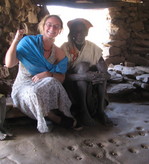 It’s a place that a lot of tourists go through, but not many actually stay in (it’s on the road just at the top of the famous Bandiagara escarpment, so on the way down to the more well-known picturesque cliff villages). And that made it a pretty good base for us: as well as doing the more well-trodden (if also very worthwhile and interesting) tourist things (e.g. seeing the animist church and visiting the togona – the men’s meeting place with purposefully low ceiling to prevent fights), we were around long enough to do a bit more (playing oware in the togona, and beating one of the village elders even though he cheated outrageously!).
It’s a place that a lot of tourists go through, but not many actually stay in (it’s on the road just at the top of the famous Bandiagara escarpment, so on the way down to the more well-known picturesque cliff villages). And that made it a pretty good base for us: as well as doing the more well-trodden (if also very worthwhile and interesting) tourist things (e.g. seeing the animist church and visiting the togona – the men’s meeting place with purposefully low ceiling to prevent fights), we were around long enough to do a bit more (playing oware in the togona, and beating one of the village elders even though he cheated outrageously!).
 This meant a chance to get to grips with some of the food, too. Bogoum took us to meet his mum, who explained how she makes her classic Malian fermented spices: soumbala and dattou. We learnt a bit about the symbolism of the main staple grain here, millet, and how it’s kept in separate granaries for men and women. We saw how they make school dinners (you guessed it – big marmites over an open fire).
This meant a chance to get to grips with some of the food, too. Bogoum took us to meet his mum, who explained how she makes her classic Malian fermented spices: soumbala and dattou. We learnt a bit about the symbolism of the main staple grain here, millet, and how it’s kept in separate granaries for men and women. We saw how they make school dinners (you guessed it – big marmites over an open fire).  We visited the beautiful onion fields, learnt how they water them all by hand using calabash gourds (now with some help from a new dam built with French regional government money), and discovered that what we’d thought was an ancient onion-growing tradition actually only dates back to the visit of a French anthropologist in the 1930s! And we got to try the millet beer that’s always being made, by different women every day, to ensure a constant supply.
We visited the beautiful onion fields, learnt how they water them all by hand using calabash gourds (now with some help from a new dam built with French regional government money), and discovered that what we’d thought was an ancient onion-growing tradition actually only dates back to the visit of a French anthropologist in the 1930s! And we got to try the millet beer that’s always being made, by different women every day, to ensure a constant supply.
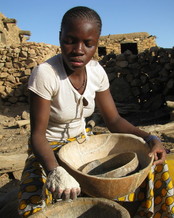 And most interesting of all, we got to spend an evening with Aminata and Allaye who taught us how to make tô with gombo sauce. Tô is the main meal for everyone around here: it’s a stiff porridge made with millet, and usually eaten with either gombo (okra) or bissap (hibiscus leaf) sauce.
And most interesting of all, we got to spend an evening with Aminata and Allaye who taught us how to make tô with gombo sauce. Tô is the main meal for everyone around here: it’s a stiff porridge made with millet, and usually eaten with either gombo (okra) or bissap (hibiscus leaf) sauce. 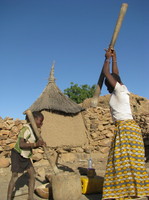 It’s hard work: there’s a lot of pounding with an enormous mortar and pestle, to turn the millet into flour; and a lot of stirring a huge marmite over hot flames. This isn’t because of an insistence on traditional methods: Aminata will happily use a Maggi cube or some MSG crystals in place of soumbala, if she has some; it’s just that millet is what they have, and this is the best way to prepare it. And prepare it she does, to feed the family every day: she’s only 15, but since her mother died it’s been her job. Thank you so much, for spending so much time with us, and giving us such an insight into regular life here.
It’s hard work: there’s a lot of pounding with an enormous mortar and pestle, to turn the millet into flour; and a lot of stirring a huge marmite over hot flames. This isn’t because of an insistence on traditional methods: Aminata will happily use a Maggi cube or some MSG crystals in place of soumbala, if she has some; it’s just that millet is what they have, and this is the best way to prepare it. And prepare it she does, to feed the family every day: she’s only 15, but since her mother died it’s been her job. Thank you so much, for spending so much time with us, and giving us such an insight into regular life here.
 We also spent some time in the villages at the bottom of the cliff: impressive mud mosques and animist shrines (the Dogon seem to be masters at mixing Islam and animism and taking what suits them from both), ancient Tellem houses and granaries, and people just getting on with life and winnowing their peanuts. I’d love to write more about these villages, and the things we learnt about Dogon society and spiritual life, but there’s so much to say, and after all, it’s been better documented elsewhere.
We also spent some time in the villages at the bottom of the cliff: impressive mud mosques and animist shrines (the Dogon seem to be masters at mixing Islam and animism and taking what suits them from both), ancient Tellem houses and granaries, and people just getting on with life and winnowing their peanuts. I’d love to write more about these villages, and the things we learnt about Dogon society and spiritual life, but there’s so much to say, and after all, it’s been better documented elsewhere.
And in the end, we’d been right to worry in a way: we didn’t really have enough time to do the
Dogon country justice. Not only did we only have a few weeks left to
get all the way through Burkina Faso and Ghana, it was nearly Tabaski! We had to get to Djenné …
 Back in Bamako, Ibrim had put us in touch with Kadidia Djennepo, who runs a NGO working on many local women’s issues, from food preservation to genital mutilation; and Kadidia then very generously invited us to spend Tabaski with her family in Djenné (the city on the Niger famous for its mosque – the largest mud brick building in the world). After an eventful ferry trip across the river (trying to bargain down a girl who wanted to exchange a small bracelet for our car and all its contents) we soon found our way to the main square to find it suspiciously quiet. Where was everyone?
Back in Bamako, Ibrim had put us in touch with Kadidia Djennepo, who runs a NGO working on many local women’s issues, from food preservation to genital mutilation; and Kadidia then very generously invited us to spend Tabaski with her family in Djenné (the city on the Niger famous for its mosque – the largest mud brick building in the world). After an eventful ferry trip across the river (trying to bargain down a girl who wanted to exchange a small bracelet for our car and all its contents) we soon found our way to the main square to find it suspiciously quiet. Where was everyone?
 All off changing clothes and getting their hair done, if the next morning was anything to judge by. Urban West Africans are nothing if not stylish, and for Tabaski they pull out all the stops. Everyone seemed to be wearing new clothes, often several family members wearing the same cloth (we’d seen all the tailors working overtime the night before to finish off everyone’s new hand-made suits). All the women and girls had intricately braided and decorated hairstyles specially for the occasion.
All off changing clothes and getting their hair done, if the next morning was anything to judge by. Urban West Africans are nothing if not stylish, and for Tabaski they pull out all the stops. Everyone seemed to be wearing new clothes, often several family members wearing the same cloth (we’d seen all the tailors working overtime the night before to finish off everyone’s new hand-made suits). All the women and girls had intricately braided and decorated hairstyles specially for the occasion.
 And at Kadidia’s house we found the sacrificial ram waiting in the courtyard downstairs. Waiting, that is, for the butcher to come round, slit its throat, skin and gut and otherwise prepare it – all within about ten minutes. He had several hundred to do that day. And now we had to decide what to cook – it has to involve mutton, of course, but other than that, it’s up to you. We went for fakouye, a rich dish from the north, full of spices we not only didn’t recognise the name of, but had never seen or smelt anything like before.
And at Kadidia’s house we found the sacrificial ram waiting in the courtyard downstairs. Waiting, that is, for the butcher to come round, slit its throat, skin and gut and otherwise prepare it – all within about ten minutes. He had several hundred to do that day. And now we had to decide what to cook – it has to involve mutton, of course, but other than that, it’s up to you. We went for fakouye, a rich dish from the north, full of spices we not only didn’t recognise the name of, but had never seen or smelt anything like before.
 But first, Kadidia showed us how to quickly cook the best bits first: the liver, kidneys and various other bits of offal (after all, you really can’t leave them lying around long in the heat). Very simple, and very delicious – surely the freshest and tastiest liver we’ve ever had.
But first, Kadidia showed us how to quickly cook the best bits first: the liver, kidneys and various other bits of offal (after all, you really can’t leave them lying around long in the heat). Very simple, and very delicious – surely the freshest and tastiest liver we’ve ever had.  Next, we turned some fresh ginger, limes and sugar into a jug of spicy refreshing ginger juice. And that was just the beginning: we spent the whole day around the marmite, happily cooking, eating and learning all about fakouye, savoury rice galettes, and more.
Next, we turned some fresh ginger, limes and sugar into a jug of spicy refreshing ginger juice. And that was just the beginning: we spent the whole day around the marmite, happily cooking, eating and learning all about fakouye, savoury rice galettes, and more.
 And slowly the visiting began: the men of the house disappeared off in their new boubous made of the shiny beaten XXX cloth, and slowly other people started appearing. Some brought food with them – big bowls of fragrant lamb couscous – and some came with empty bags expecting food. Tabaski’s all about sharing – you sacrifice your own ram, then you give what you have spare to people who need it more. (Perhaps we could learn a thing or two about how to improve Christmas.) And it’s all about visiting your friends and relatives – the visits may not last very long (there’s a lot to fit in!) but you mustn’t miss any out. This was only the first day, with the men and the kids doing the visiting; tomorrow Kadidia would start her tour.
And slowly the visiting began: the men of the house disappeared off in their new boubous made of the shiny beaten XXX cloth, and slowly other people started appearing. Some brought food with them – big bowls of fragrant lamb couscous – and some came with empty bags expecting food. Tabaski’s all about sharing – you sacrifice your own ram, then you give what you have spare to people who need it more. (Perhaps we could learn a thing or two about how to improve Christmas.) And it’s all about visiting your friends and relatives – the visits may not last very long (there’s a lot to fit in!) but you mustn’t miss any out. This was only the first day, with the men and the kids doing the visiting; tomorrow Kadidia would start her tour.
 After that, it’s all a bit of a blur. I know we went out dancing at the local youth club with Mady, watched a lot of energetic dancing and drank a lot of Fanta. But it’s the fakouye I really remember. All in all, we couldn’t have imagined a more perfect Tabaski. We got to learn all about what people eat, how they cook it, and all the social ritual that goes on around it – and really felt like part of the family while we were doing it. Many many thanks to Kadidia (and all the other Kadidias) for being so generous and for making us feel so at home.
After that, it’s all a bit of a blur. I know we went out dancing at the local youth club with Mady, watched a lot of energetic dancing and drank a lot of Fanta. But it’s the fakouye I really remember. All in all, we couldn’t have imagined a more perfect Tabaski. We got to learn all about what people eat, how they cook it, and all the social ritual that goes on around it – and really felt like part of the family while we were doing it. Many many thanks to Kadidia (and all the other Kadidias) for being so generous and for making us feel so at home.
The next day, to avoid anticlimax we thought we should head for Burkina Faso. So after exploring Djenne a bit – the architecture’s amazing, the whole town’s full of classic Moroccan- and Tukulor-style mud-brick houses, and it’s remarkably quiet once you get off the main square – we took the road south.
 The landscape got steadily greener; and when we stopped in Koutiala for the night, the markets seemed quite different, full of bright green leaves and vegetables (although obviously still also full of soumbala and delicious cheap omelette sandwich breakfasts).
The landscape got steadily greener; and when we stopped in Koutiala for the night, the markets seemed quite different, full of bright green leaves and vegetables (although obviously still also full of soumbala and delicious cheap omelette sandwich breakfasts).  We got ready to say goodbye to Mali and head for the border, but remembered just in time that we hadn’t bought a galette pan: you need a special shape, with a flat plate covered in round depres
We got ready to say goodbye to Mali and head for the border, but remembered just in time that we hadn’t bought a galette pan: you need a special shape, with a flat plate covered in round depres
sions.
This being Mali, it didn’t take long to find someone selling them, made of recycled paint tins (as so much here is: he was busy making a charcoal brazier out of the wire rims from used bicycle tyres). He didn’t have the special spoon to go with it, though; but, this being Mali, he disappeared off on his scooter, found a blacksmith, got one specially forged for us, and then didn’t really want to accept any money for it. A perfect reminder of how generous and friendly people here are; and we set off for the border hoping Burkina would be no different. It wouldn’t take us long to find out …

 Follow
Follow
Comments are closed